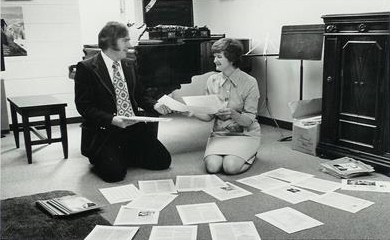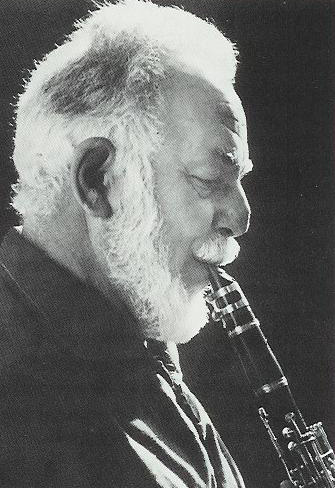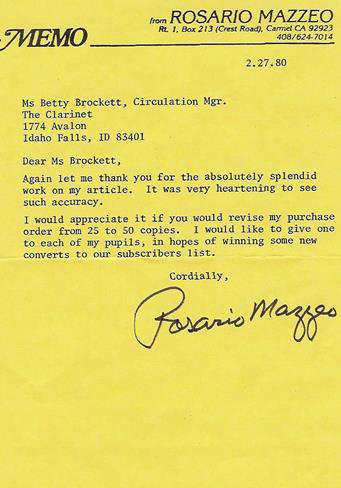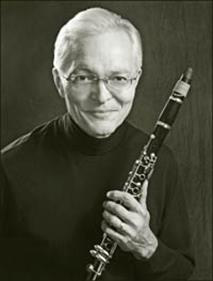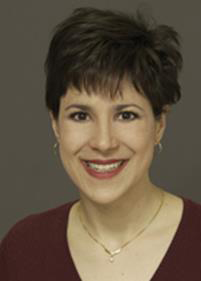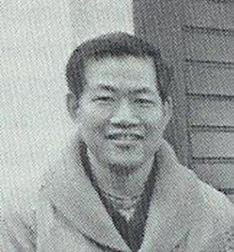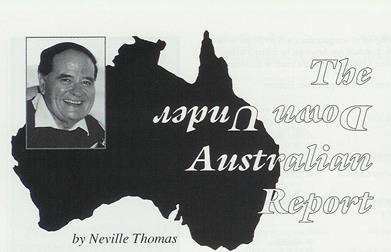On the 40th Anniversary of the Association: 1973-2013
“The Evolution of a Good Idea”
The history of the International Clarinet Association chronicles countless individuals, fabulous annual conferences, one of the most outstanding and scholarly of all single instrument journals, and much more. The birth of our organization began as a “Good Idea”.
The University of Denver’s (DU) National Clarinet Clinic contributed much to our history. Ralph Strouf, then professor of clarinet at DU recalled how planning for the university’s centennial in 1964 resulted in a call for national conferences on their campus. The university’s president said he would fund qualified conferences. Ralph’s “good idea” to have a clarinet festival was proposed, funded, and clarinet enthusiasts gathered for a five-day clinic at DU in July 1964. Ralph asked his teacher and mentor, the late Keith Stein, to serve as the artistic director so that he could coordinate the logistics of such a conference. Keith was enthusiastic and immediately suggested that the new clarinet teacher at Michigan State University, Elsa, be invited. [Elsa Ludewig-Verdehr was the clarinet professor at MSU from 1964-2007.] As a Denver native I attended some of those early clinics and was fortunate to meet and hear some of the world’s greatest performers of the day, rub elbows with pedagogues, play in a clarinet choir for the first time, peruse clarinet methods and music collections provided by Wells Music of Denver and soon thereafter, Luyben Music of Kansas City, and sample the instruments and accessories of local music vendors and the major manufacturers of the day – Selmer, Leblanc, Buffet, and Conn. In 1967, Strouf resigned for a new position at the new Metropolitan State College in Denver. That summer, Ramon Kireilis, having just finished his doctorate at the University of Michigan, was invited to interview for the open position during the 1967 National Clarinet Clinic. The DU School of Music administration wanted their prospective clarinet professor to know about this successful national clinic so it could be continued in coming years.
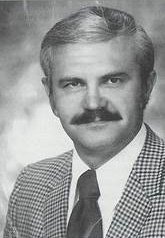
Ralph Strouf (1926-2002)
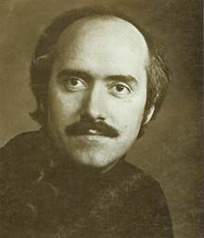
Ramon Kireilis, Founder I.C.S. and President from 1973-1978
At the 1973 National Clarinet Clinic Ramon gathered clinic participants to form what was to be known as the International Clarinet Society (I.C.S.), with a mission statement, officers, committees, and an official quarterly journal, The Clarinet. Bylaws were written and adopted and the Articles of Incorporation were officially filed on August 15, 1975. The Society’s mission statement has evolved into the following:
“The International Clarinet Association is a community of clarinetists and clarinet enthusiasts that supports projects that will benefit clarinet performance; provides opportunities for the exchange of ideas, materials, and information among its members; fosters the composition, publication, recording, and distribution of music for the clarinet; encourages the research and manufacture of a more definitive clarinet; avoids commercialism in any form while encouraging communication and cooperation among clarinetists and the music industry; and encourages and promotes the performance and teaching of a wide variety of repertoire for the clarinet.
To these ends, the association is dedicated to fostering communication and fellowship of clarinetists on a worldwide basis through publishing a quarterly scholarly journal, The Clarinet, producing an annual clarinet festival, ClarinetFest®, supporting a research library with materials available to all members, and promoting a variety of other endeavors related to the clarinet and clarinet playing.”
First Officers of the Society
Ramon Kireilis was the first President of the new society. Quoting from The Clarinet, Vol. 1, No. 1, “It should be noted that although Kireilis, director of the Clinic, was elected president of the Society, the latter is a completely autonomous and independent group. The presence of Kireilis in the Society will be of great value to the Society, and it is to be hoped that the Society will in its turn be advantageous to the Clinic.” From 1974 on, the Society was invited to hold its annual business meeting during the Clinic. In other words, Kireilis organized the Clinic each summer at the University of Denver and the Society held its annual business meeting at the Clinic. The late Lee Gibson (1915-2013), Kireilis’ mentor from North Texas State University, volunteered to be the editor of the Society’s publication, The Clarinet. Lee became President in 1978 when Kireilis wanted to devote his full energies as director of what had now become, the International Clarinet Clinic.
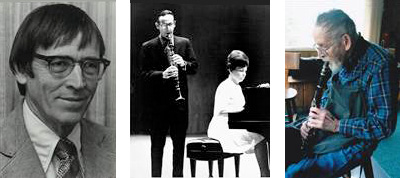
Lee Gibson, I.C.S. President 1978-1980 First Editor of The Clarinet (1973-1978) (b. 1915, d. 2013)
Other officers included Leon Russianoff of the Juilliard School in New York as Vice President, Robert Schott of Kansas State College of Pittsburg, Kansas as Secretary/Treasurer and Research Chair. H. James Schoepflin of Idaho State University in Pocatello, Idaho was Publisher. Regional Chairmen for the United States and National Chairmen for eastern and western Canada, Australia, Austria, England, and Mexico were named. A Vacancy Service was established for aspiring university teachers and symphony positions under the directorship of Harold Ashenfelter of Antioch College. In 1974 and continuing until 1977, Jack Snavely of the University of Wisconsin-Milwaukee coordinated the Vacancy Service.
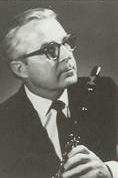
Robert Schott (1924-2005)
First Secretary/Treasurer 1973-1975
Research Chair 1974
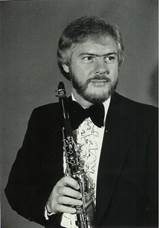
H. James Schoepflin
Publisher The Clarinet
(1973-1983)
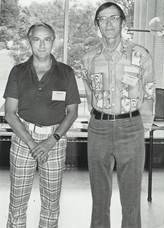
Jack Snavely with Lee Gibson
Vacancy Service Coordinator
1974-1977
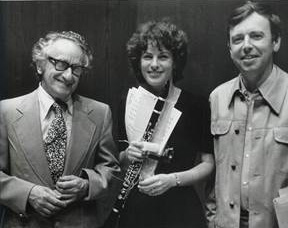
Leon Russianoff (1916-1990) with
Michele Zukovsky & Hans Rudolf-Stalder
at an early Denver Clinic
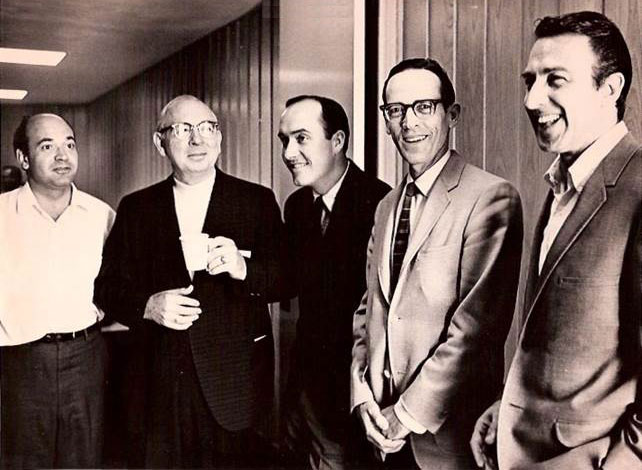
Harold Wright, George Waln, Ramon Kireilis, Lee Gibson, and Buddy DeFranco at an early Denver Clinic
Drafting our legal incorporation documents was attorney, Harry “Bud” Rubin from York, Pennsylvania. Quoting from Julie DeRoche, a past I.C.A. president, “Bud Rubin is the most important volunteer we have ever had. His generosity has been equaled only by his expertise. Consistently refusing to even allow the I.C.A. to pay his conference registration, he is to our organization what a good reed is to a clarinetist, a rare and cherished find.”
Jerry Pierce was the third I.C.S. President. One of the last of Daniel Bonade’s students, Jerry had a “deep interest in the repertoire of the clarinet”. His Pierce’s Potpourri in The Clarinet magazine detailed many obscure and hard-to-find clarinet compositions – real treasures for clarinetists everywhere. After his death in 1994, the Association purchased his extensive clarinet library for the I.C.A. Research Center at the University of Maryland. Jerry’s wife, Linda, coordinated the Society’s Commissioning Project for several years.
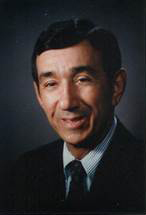
Harry (Bud) Rubin
I.C.A. Attorney since 1976
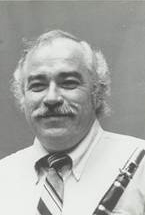
Jerry Pierce (1937-1994)
I.C.S. President 1980-1986
Jerry Pierce was the third I.C.S. President. One of the last of Daniel Bonade’s students, Jerry had a “deep interest in the repertoire of the clarinet”. His Pierce’s Potpourri in The Clarinet magazine detailed many obscure and hard-to-find clarinet compositions – real treasures for clarinetists everywhere. After his death in 1994, the Association purchased his extensive clarinet library for the I.C.A. Research Center at the University of Maryland. Jerry’s wife, Linda, coordinated the Society’s Commissioning Project for several years.
The officers met annually at clarinet clinics to discuss the business of the society. During Pierce’s tenure the officers felt a longer time away from the exciting performances and clinics was needed in order to devote our energies to the future of the organization. The first mid-year meeting was held in Chicago the fall of 1981. Such mid-year meetings continue to be held as the association matures. Initiation of and funding for projects was discussed, updating sections of the Conference Handbook were hashed out, proposals for upcoming conference sites were discussed, and ideas for growing our membership were paramount.
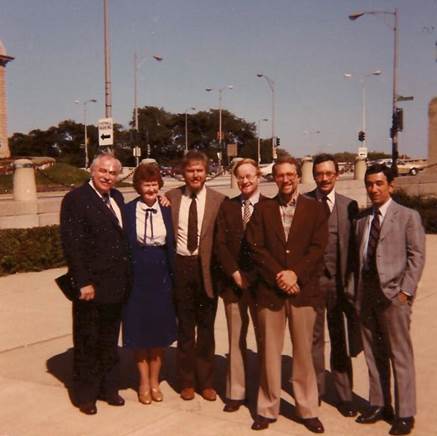
I.C.S. 1981, First Mid-Year Board Meeting in Chicago
Jerry Pierce, Betty Brockett, Jim Schoepflin, Jim Gillespie, Alan Stanek, Dan Sparks, and Harry Rubin
In 1981-82 another clarinet organization made its appearance – ClariNetwork International, Inc. (C.I.) Reasons for this competing organization are many. A perceived notion that membership and the organization’s officers were primarily from the academic world (college/university professors), it appeared that there was a need for an organization that included and/or paid more attention to professional (symphony orchestra) performers, and that annual meetings and conferences, having been held mostly in Denver (no east or west coast meetings of I.C.S. had yet been held), needed more varied locations. John Mohler as I.C.S. President, along with Ed Riley President of C.I., and Gerry Errante (the only person to have been President of both organizations at one time or another), dealt mainly with getting the two organization merged as one. Prior to the Virginia Commonwealth University (VCU) Clarinet Conference (Richmond, Virginia) in 1988, “a meeting of members of both boards of directors was held in Des Moines, Iowa and subsequent articles were published in The Clarinet explaining to the members the plan of merger. Harry Rubin, legal counsel to the Society, explained how the corporate merger was to take place and moved that the merger be approved by the members in attendance at the meeting. The motion was seconded by Leo Chak and unanimously approved by the 59 members present.” At the VCU conference John Mohler and Chuck West, with Bud Rubin from I.C.S. and Gerry Errante, Ed Riley and Daniel Levy from ClariNetwork International, Inc. and others, facilitated the merger. The merged organization had the unwieldy name – International Clarinet Society/ClariNetwork International, Inc. In 1991 the name was changed by a vote of the membership to International Clarinet Association (I.C.A.).
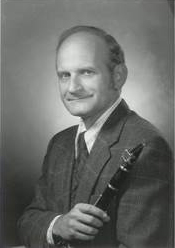
John Mohler, President 1986-1988
International Clarinet Society/
ClariNetwork International
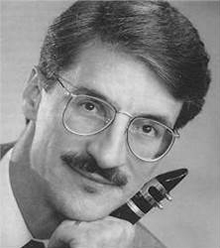
Charles West, President 1988-1990
International Clarinet Society/
ClariNetwork International
The Officers of the Association
Presidents
- Ramon Kireilis, 1973-1978 (I.C.S.)
- Lee Gibson, 1978-1980
- Jerry Pierce, 1980-1986
- John Mohler, 1996-1988
- Charles West, 1988-1990 (I.C.S./C.I.)
- Fred Ormand, 1990-1992 (I.C.S./C.I.)
- Howard Klug, 1992-1994 (I.C.A.)
- F. Gerald Errante, 1994-1996
- Alan Stanek, 1996-1998
- Robert Spring, 1998-2000
- Julie DeRoche, 2000-2002
- Robert Walzel, 2002-2004
- Michael Galván, 2004-2005
- Lee Livengood, Acting President 2005-2006 – President 2006-2008
- Gary Whitman, 2008-2010
- Keith Koons, 2010-2012
- John Cipolla, 2012-2014
- Maxine Ramey, 2014-2015
- Caroline Hartig, Acting President 2015-2016 – President 2016-2018
Fred Ormand encouraged the formulation of regional clarinet festivals and the recognition of those whose lifetime achievements had meant so much to the clarinet world and was intimately involved with the merger of I.C.S. and C.I.. Howard Klug, host of the 1987 Conference at the University of Illinois, in Urbana-Champaign, separated the High School and Young Artist Competitions, encouraged the formation of regional clarinet clubs, and established the Composition Competition. His pedagogical column was a welcome addition to the journal. He, tongue-in-cheek, declared himself “the Education President.”
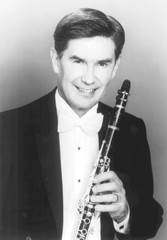
Fred Ormand, President 1990-1992
I.C.S./C.I.
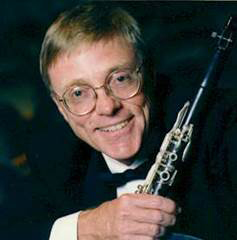
Howard Klug, President 1992-1994
I.C.A.
Gerry Errante encouraged the membership in the Adopt-A-Member Program to help enlist clarinetist from underdeveloped countries, established the I.C.A. Research Committee with Keith Koons as Chair, organized the purchase of Jerry Pierce’s library for the I.C.A. Library (coordinating with the University of Maryland), and proposed putting the Clarinet Anthology online (a compilation of articles from the older Clarinet magazine, and new research articles from the “Paper & Poster Presentation” Competition). Alan Stanek, as president-elect under Gerry Errante, made contact with Stan Geidel to get our website established. During his presidency, the association celebrated its 25th anniversary at the 1998 ClarinetFest® at Ohio State University and acknowledged the 4,000th member of the association, a feat not reached again until 2011. The results of a Member Questionnaire gave the Board of Directors information and guidance to direct and improve the association and the journal. Requests included the desire for an east coast conference (resulting in the 2004 ClarinetFest® at the University of Maryland near Washington, D.C.) and conferences on other continents (Tokyo, Japan in 2005), more jazz related articles, and educational materials in The Clarinet, and a request to get the Research Library Catalog online.

F. Gerard Errante
President 1994-1996
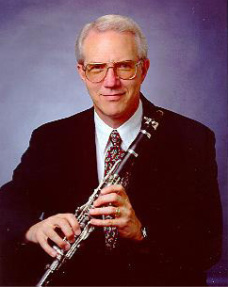
Alan E. Stanek
President 1996-1998
Bob Spring’s administration authorized the funds to get the RESEARCH LIBRARY Catalog online. The online catalog is very easy to use and a valuable resource to all I.C.A. members. Bob also hosted the ‘97 ClarinetFest® in Tempe, and we were given a “warm” reception (temperatures averaged 100˚-114˚). Julie DeRoche, the first female I.C.A. president, hosted the ‘94 Chicago ClarinetFest®, one of the largest conferences up that point in our history. Newly released (2013) photos from the ’94 Chicago ClarinetFest® appear under the Annual Conventions heading below. Julie’s board initiated a Grant Competition in 2002, which funded regional clarinet gatherings, research projects, etc. Discussions at Board meetings began focused discussions on controlling all aspects of ClarinetFests, such as organization, artistic considerations, exhibitors, advertising and finances. The association’s control of ClarinetFests had been a long-term goal of several presidents going back to at least Fred Ormand and is now a reality.
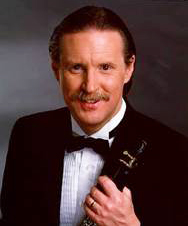
Robert Spring, President 1998-2000
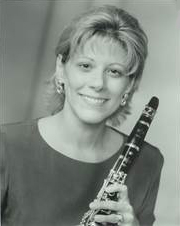
Julie DeRoche, President 2000-2002
Robert Walzel, hosted the ‘97 Texas Tech ClarinetFest® in Lubbock, served as Treasurer 96-98, and is credited with convincing Kathy Pope to put in a bid for a future conference at the University of Utah at the 2000 mid-year Board meeting. This was two years before Bob even knew there would be an administrative position for him in the University of Utah School of Music.
Michael Galván’s presidency included furthering of the concept of total control of ClarinetFests and presiding over the Tokyo/Tama, Japan conference. In December 2005, Michael resigned, as President and Lee Livengood became Acting President for the remainder of Michael’s term. Bob Walzel offered historical perspective.

Robert Walzel
President 2002-2004
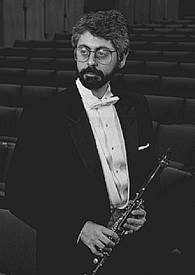
Michael Galván
President 2004-2005
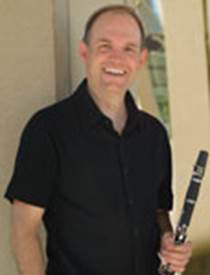
Lee Livengood
President 2005-2008
During Gary Whitman’s term of office the I.C.A. website was revamped. The Board hired Brian Covington as our web master and charged him with the task of creating a new user friendly website. Brian created a Members Only section to place back issues of the magazine on the website, as well as pedagogy articles, master-classes, and videos. It was also at this time that I.C.A. joined Facebook and explored the use of social media to promote membership and attendance at ClarinetFest® conferences. Electronic voting for officers began in the spring of 2010. The Board brought back the Composition Competition and entered into a joint commissioning project with our sister organizations to create a woodwind quintet, N.F.A. (National Flute Association), I.D.R.S. (International Double Reed Society), and I.H.S. (International Horn Society). The process started in 2009 and resulted in a performance of Hardwood for Wind Quintet by Lansing McLoskey at ClarinetFest® 2012 in Lincoln, Nebraska.
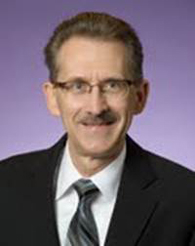
Gary Whitman
President 2008-2010
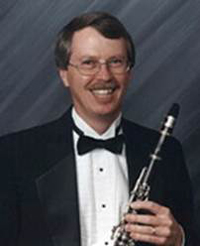
Keith Koons
President 2010-2012
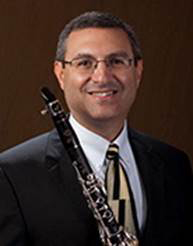
John Cipolla
President 2012-2014
Keith Koons’ presidency culminated with the departure of So Rhee from the Executive Director’s position and the transition to a professional management company (Madeleine Crouch & Co., Inc.) on January 1, 2012. The establishment of a National Chair Coordinator brought Belgium’s Eddy Vanoosthuyse on board. Several new initiatives include:
- An Online Store for I.C.A. members and a quarterly electronic newsletter
- The initiation of an International Access Initiative – a program to offer Associate Membership to interested clarinetists outside the U.S.A. who cannot afford regular membership.
Vice Presidents
- Leon Russianoff (1916-1990), 1973-1976
- Philip Aaholm, 1976-1978
- Glenn Bowen, 1978-1980
- Dan Sparks, 1980-1982
- David Etheridge, 1982-1986
- Alan Stanek, 1986-1988
After 1988 the Bylaws eliminated the office of vice president and incorporated the position of president-elect, with each office term to be two years. Secretaries and Treasurers could be re-elected for additional two-year terms.
Secretary/Treasurer (1973-1978) and Treasurers:
- Robert Schott (1924-2005), 1973-1975
- David Randall, 1975-1978
At the 1978 Toronto, Canada Conference, the Secretary/Treasurer position was split.
- David Randall, 1978-1981
- H. James Schoepflin, 1981-1986
- Charles West, 1986-1988
- Ted Jahn (1939-2001), 1988-1992
- Konrad Owens, 1992-1996
- Julie DeRoche, 1996-1998
- Robert Walzel, 1998-2000
- Kelly Burke, 2000-2004
- Diane Cawein-Barger, 2004-2010
- Kathy Pope, 2010-2012
- Tod Kersetter, 2012-2021
Secretaries (from 1978):
- Alan Stanek, 1978-1984
- Norman Heim, 1984-1986
- David Pino, 1986-1988
- Patricia Kostek, 1988-1996
- Maurita Murphy-Mead, 1996-2002
- Michéle Gingras, 2002-2004
- Kristina Belisle Jones, 2004-2008
- John Cipolla, 2008-2010
- Maxine Ramey, 2010-2012
- Caroline Hartig, 2012-2014
- Denise Gainey, 2014-2018

Maxine Ramey 2010-2012
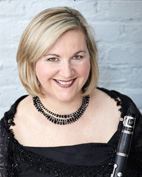
Caroline Hartig 2012-2014
Keeping track of the membership was the responsibility of the Secretary until our membership grew to the point that it was becoming unmanageable. Upon the merger of I.C.S./C.I. in 1988, Robin Ulman-Anderson became Membership Coordinator. Elena Lence-Talley was appointed in 1990. Rose Sperrazza put together a new Membership Brochure, authored a new and interesting column in the magazine (Reed All About It) and was proposed as the first Executive Director in 2003. So Rhee was hired full-time as Executive Director in September 2005. Madeleine Crouch of Madeleine Crouch & Co., Inc. began a new relationship in 2012 as Executive Director and oversaw ClarinetFest® 2012 in Lincoln, Nebraska. Lynn Fryer was hired full-time as Executive Director in 2015. Evan Lynch was hired as Interim Executive Director in March 2016 and then hired full-time as Executive Director in September 2016 following ClarinetFest® 2016 in Lawrence, Kansas.
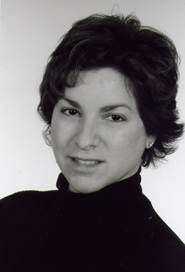
Rose Sperrazza
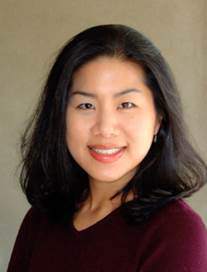
So Rhee

Madeleine Crouch
The Clarinet
The official quarterly journal – The Clarinet, Volume 1, Number 1 was a mimeographed, loose-leaf issue that introduced the clarinet world to a new organization – the International Clarinet Society (see scan of cover below). Lee Gibson edited the journal for its first five years and Jim Gillespie celebrated his 35th year as editor in 2013. The photograph of clarinetist David Shifrin was the first to grace a cover of The Clarinet, Vol. 1, No. 2. Publisher H. James Schoepflin was responsible for my involvement with the association. As consecutive Chairs of the Department of Music at Idaho State University, we enjoyed our association with Betty Brockett, as our adult student and as The Clarinet’s Publishing Associate. ISU Graphic Arts printed the first page of the new journal in collaboration with graphic artist, Jeff Webster, who fashioned the stylized and colored “mouthpiece”(sic) logo.
Except for the multiphonic fingering chart autographed by composer Barney Childs, the department secretary, Rayna Faler, typed and pasted together the remainder. Galleys of the early issues of the magazine were proofed and after printing in Idaho Falls, the magazines were inserted into manila envelopes on the floor of the chairman’s office at ISU and mailed through the campus post office (Permit No. 42). Jim recounted that Lee Gibson would send a packet of articles, etc., some hand written, other typed for each issue. He and Rayna, and soon Betty Brockett, would reconstruct everything, then hand carried to Litho Printing in Pocatello where the type was handset and eventually printed.
The journal has had several Editors of Reviews and an Associate Editor of Reviews for Recordings. Jim Sauers’ Record Rumbles complimented Jerry’s Pierce’s Potpourri. Together one could learn about the clarinet repertoire and hear those who recorded it. Joseph Messenger was Editor of Reviews from 1988 to 2008. Gregory Barrett assumed this responsibility in 2009 to the present. The Editor of Reviews receives and distributes music sent by publishers for review. Brad Wong and Bill Nichols served as Audio Review Editors. Together, these gentlemen have distributed new music and recordings for review by a variety of individuals to be included in The Clarinet. A complete listing of all Association affiliates appears on page 3 of every issue of the journal.
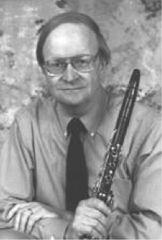
James Gillespie, Editor The Clarinet
1978 to present
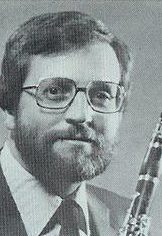
Joseph Messenger
Editor of Reviews
1988-2008
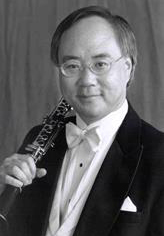
Brad Wong
Audio Review Editor
1988-1996
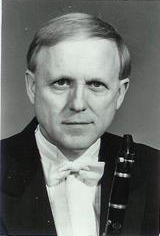
William Nichols
Audio Review Editor
1996 to present
Advertising Managers have helped keep the journal on a financial footing and the association solvent. Bob Luyben, of Luyben Music in Kansas City, Missouri made phone calls to potential businesses in the beginning and Jim Schoepflin handled all the details of magazine advertisements the first ten years of the Society. Gary Whitman was employed by the Board to coordinate exhibitors at all ClarinetFest®s since Jim Pyne’s OSU conference in Columbus, Ohio where he was sent by the board to observe the process. This has relieved the conference host from this overwhelming task. This was the board’s first small step in gaining financial and organizational control of the entire ClarinetFest® event. The Executive Director in conjunction with ClarinetFest® hosts now has this responsibility.
Editor Jim Gillespie has convinced many outstanding individuals to write special columns over the years. Mazzeo Musings by Rosario Mazzeo, former bass clarinetist in the Boston Symphony, offered discussions of repertoire. Michael Webster followed Howard Klug, offering pedagogical articles in the magazine; Michael is a long-term author of a series entitled Teaching Clarinet. His Webster’s Web, an email Question/Answer feature, has generated considerable interest from readers. More recently, Larry Guy and Kimberly Cole Luevano have more recently authored the Pedagogy Corner.
International Reporters have informed the membership of clarinet happenings around the world from Australia to Zimbabwe. Tsuneya Hirai did this for Japan before his passing in 2010. Tsuneya and the late Neville Thomas from Australia were our most consistent correspondents. Australia and Japan have well over 300 members of their respective national clarinet societies. More recently, we hear quarterly from Paul Harris of the United Kingdom, Jean-Marie Paul of France, Ricardo Dourado Freire for Latin America, and others around the globe.
Some of Jim Gillespie’s Favorite Covers
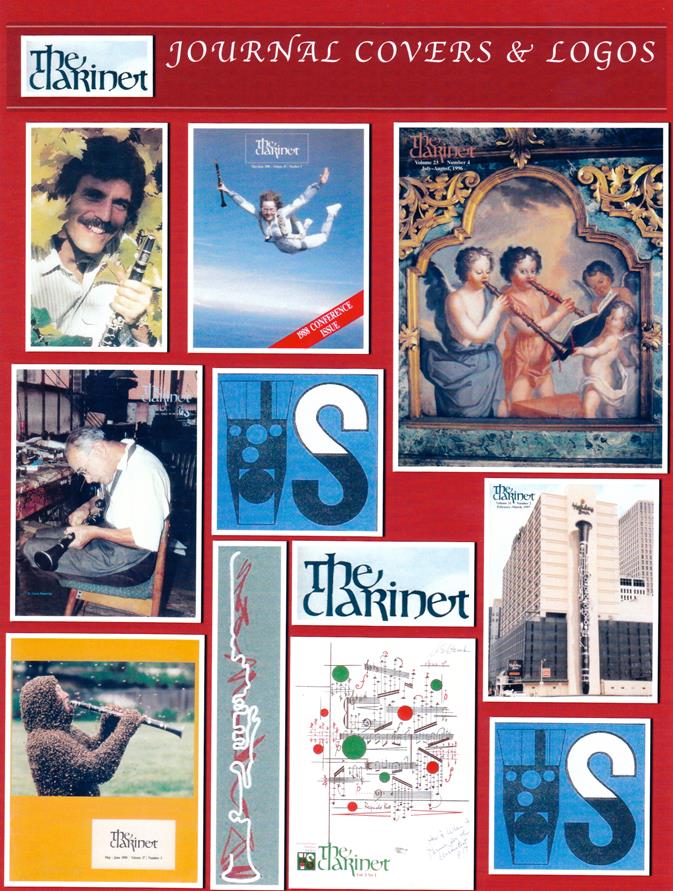
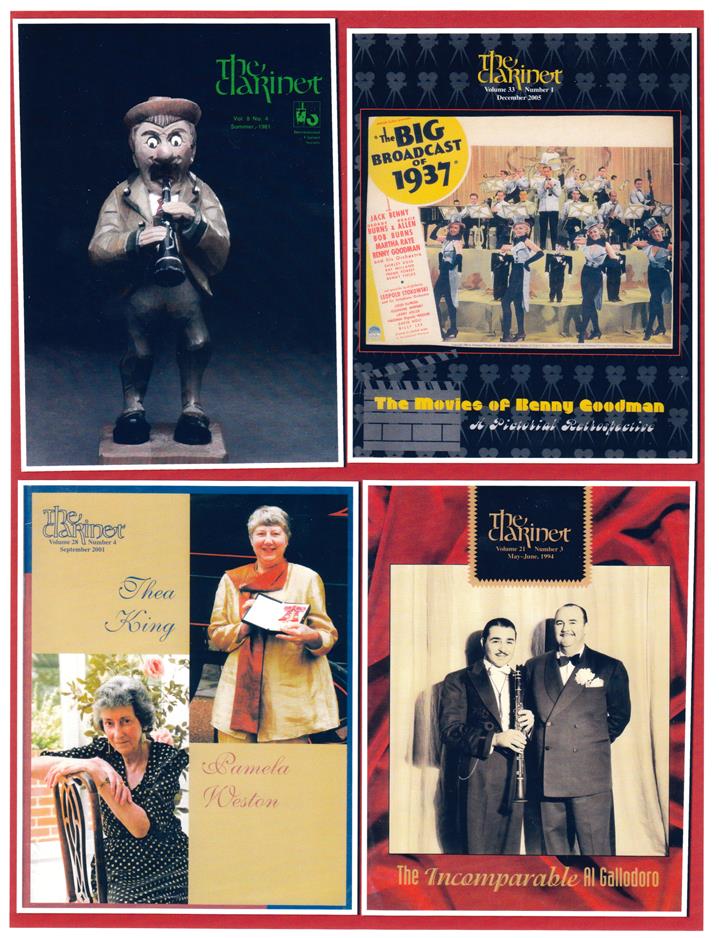
Annual Conventions
There has been an evolution of annual convention titles from Clinic to Congress, to Conference, to ClarFest, to ClarinetFest®. Note that ClarinetFest® is a registered name of the association. Reports of each conference with numerous pictures are published in The Clarinet, usually in the November-December or December issue of each volume.
At those early Denver clinics, Frank Stachow of Lebanon Valley College, Pennsylvania, recorded all performances on reel-to-reel tape. Kireilis related this humorous story about Frank. Frank stood up at one of the conferences and said, “After 10 years hearing the same ‘BS’ about practice, I want to know the real secret.” Kireilis ventured the thought that “perhaps all we needed to do was change the way we spelled our name.” For example, Bill Jackson changed his name to Bil; Greg Smith changed his to Gregg. Early performers and presenters at Denver included Leon Russianoff, Michele Zukovsky, and Hans Rudolf Stalder.

Frank E. Stachow, early Northeast Regional Chair
Frank tape-recorded many Denver Clarinet Clinics
One of the features of those early Denver meetings was the networking of professional performers, high school and college/university teachers, amateurs, and industry personnel. There was often a banquet for all participants held in the DU Student Union or a local hangout near the campus – a beer, pizza, and Italian sausage sandwich place called La Fontanella where entertainment was provided by conference attendees. A photo of participants at one early annual meeting included: Jim Schoepflin, Jim Gillespie, the late Betty Brockett, Alan Stanek, Dan Sparks, Stephen Clark, David Etheridge (another Denver native and founder of the Oklahoma Clarinet Symposium), Michael Bryant and Pamela Weston from the U.K., Henry Duckham, Glenn Bowen, Phil Aaholm, John Mohler, Jon Anderson, John Scott, and many others – names synonymous with the early organization.

Entertainment for Banquet @ La Fontanella
John Denman, Jerry Pierce, Lee Gibson, Alan Stanek
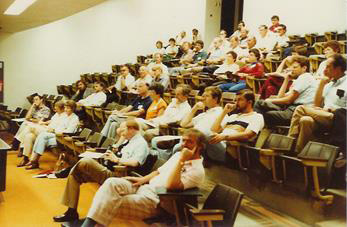
Early I.C.S. Business Meeting in Denver
Early on there were clarinet choirs of clinic participants that continue today. Don Ambler, Bass Clarinetist of the Denver Symphony helped organize these early ensembles. Conductors included Russell Howland, Frank Stachow, Lucian Calliett, and others. In recent years ClarinetFests® have included a Festival Choir and a College Choir. Conductors have included Harvey Hermann, Julie DeRoche, David Etheridge, Mitchell Estrin, Charles West, Raphael Sanders, and Robert Walzel and Alan Stanek in Lincoln in 2012.
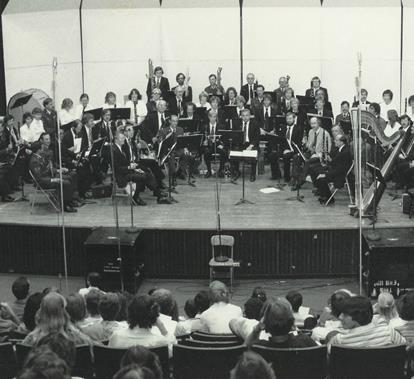
Clinic Participants in Clarinet Choir
University of Denver
After the Toronto Congress in 1978, the first Congress outside of North America was held in 1981 in Paris, France. Guy Deplus and the Paris Clarinet Quartet, especially Michel and Anne-Marie Gizard, were our hosts. Going through the Buffet factory was a special event for Congress attendees. Pamela Weston was our host for the London meeting in 1984. Her books, Virtuosi of the Past, etc. are must reeds! The bass clarinet has become a more prominent feature of our annual conferences.
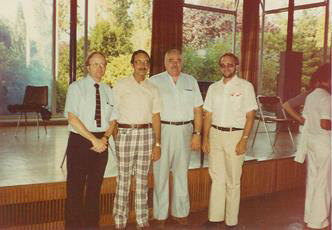
I.C.S. officers in Paris, France – 1981
International Clarinet Congress
at Cité Universitaire
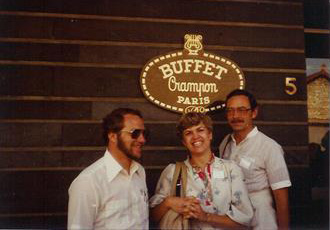
Paris, France – July 1981
Alan Stanek, Kathleen Jones, and Dan Sparks
The 1985 conference at Oberlin was highlighted by the appearance of Artie Shaw. We heard recordings made in the 1940’s by the movie studios (they had better recording equipment than RCA according to Mr. Shaw) that had never been released – many are now available. We also saw a documentary video entitled Time Is All You’ve Got, an autobiography of Shaw’s very interesting life. For those who have read his The Trouble With Cinderella – An Outline of Identity, might also want to peruse his short novel: I Love You, I Hate You, Drop Dead. In the preface he offers “Five Simple Steps to Become a Genius”. Here are the steps: 1. Find yourself a genius. 2. Make friends with him. 3. Following him around. 4. Watch what he does. 5. Do it. He goes on to say, “The first rule is, of course, the toughest one, and to make it even tougher, there’s no guarantee you’ll ever be a genius. One thing you can bet on, though: if you keep at it long enough, you’ll get pretty good at whatever it is you’re trying to do. And you’ll certainly know quite a lot about what it takes. Remember, I said five simple steps, not easy ones.”
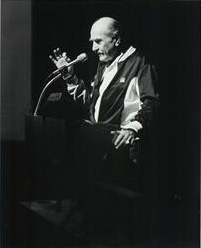
Artie Shaw at Oberlin, 1985
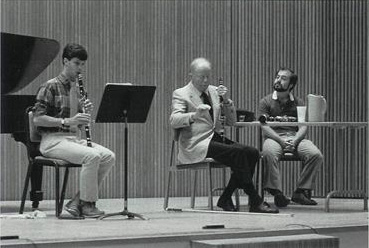
Robert Marcellus (1928-1996)
Master Class at Oberlin, 1985
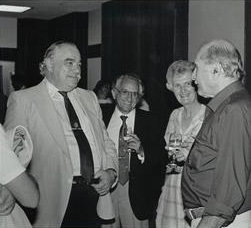
Jerry Pierce, Leon Russianoff, Betty Brockett,
and Artie Shaw at Oberlin, 1985
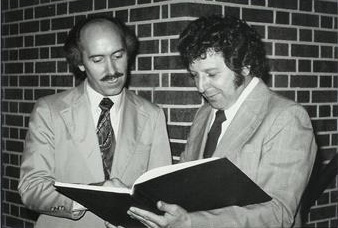
Ray Kireilis and John Denman with new
orchestral score to Spohr, Clarinet Concerto, No. 2
The first of several large group music events was also held at the 1985 Conference at Oberlin College, Ohio. Black Box Music by Conrad Cummings involved all conference attendees in an outside performance. Bill McColl hosted the ‘86 conference in Seattle where William O. (Bill) Smith’s Line Up music may have set the Guinness World Record for the longest line up of clarinetists. Approximately 150 fellow clarinetists in Cincinnati with Erich Kunzel and the Cincinnati Pops Orchestra performed Clarinet Polka. 280 ClarinetFest® participants set a new record performing When the Saints Go Marching In with the Columbus Symphony at Jim Pyne’s ClarinetFest® in Columbus in 1998. Jim personalized his 1998 ClarinetFest® with a festival and symposium entitled Vienna and the Clarinet. Hearing the beautiful sound of basset horns in Mozart’s Requiem was inspiring. Guido Six, will be remembered for his conferences in Ghent, Belgium in ‘93 with Freddie Artel, and again in ‘99 in Ostende, the “Claribel Clarinet Choir”, and, of course, his late evening “Biermeister” duties with Belgium chocolates and that delightful liquid refreshment. A unique highlight of the 2012 ClarinetFest® in Lincoln, Nebraska was the Stonaker Contra Clarinet Ensemble performing Geometric Fragments No. 4 for 44 Contra-Clarinets. Each conference has had memorable moments too numerous to include here.
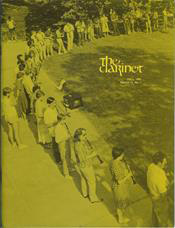
Black Box Music by Conrad Cummings
1985 Conference at Oberlin College, Ohio
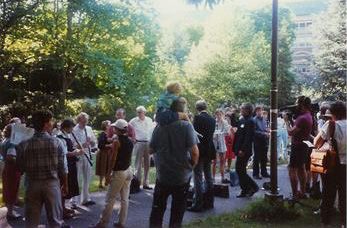
Performance of W.O. Smith’s Line Up
at Seattle Clarinet Conference, 1986
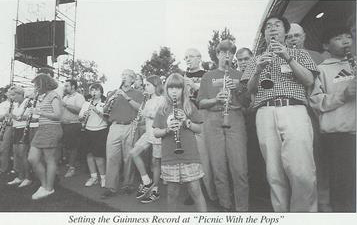
280 participants performing “When the Saints Go Marching In” with the Columbus Symphony.
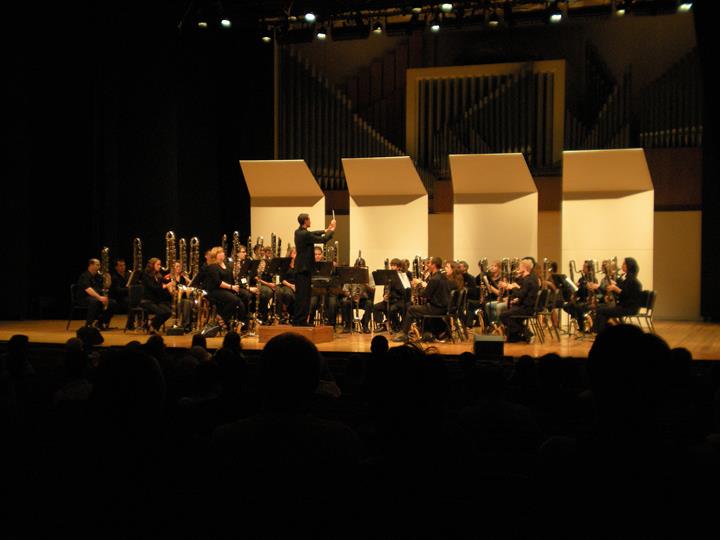
Stonaker Contra Clarinet Ensemble performing Geometric Fragments No. 4 for 44 Contra-Clarinets 2012
Newly released photos from ’94 Chicago ClarinetFest® – Julie DeRoche, Host
Conference Locations
- 1974-1977, U.S.A. – Denver, Colorado
- 1978, CANADA – Toronto
- 1979-1980, U.S.A. – Denver, Colorado
- 1981, FRANCE – Paris
- 1982-1983, U.S.A. – Denver, Colorado
- 1984, ENGLAND – London
- 1985, U.S.A. – Oberlin, Ohio
- 1986, U.S.A. – Seattle, Washington
- 1987, U.S.A. – Urbana-Champaign, Illinois
- 1988, U.S.A. – Richmond, Virginia – A joint I.C.S. Conference/ClarFest with C.I.
- 1989, U.S.A. – Minneapolis, Minnesota
- 1990, CANADA – Quebec City
- 1991, U.S.A. – Flagstaff, Arizona
- 1992, U.S.A. – Cincinnati, Ohio
- 1993, BELGIUM – Ghent
- 1994, U.S.A. – Chicago, Illinois
- 1995, U.S.A. – Tempe, Arizona
- 1996, FRANCE – Paris
- 1997, U.S.A. – Lubbock, Texas
- 1998, U.S.A. – Columbus, Ohio
- 1999, BELGIUM – Ostende
- 2000, U.S.A. – Norman, Oklahoma
- 2001, U.S.A. – New Orleans, Louisiana
- 2002, SWEDEN – Stockholm
- 2003, U.S.A. – Salt Lake City, Utah
- 2004, U.S.A. – Washington, D.C.
- 2005, JAPAN – Tokyo/Tama
- 2006, U.S.A. – Atlanta, Georgia
- 2007, CANADA – Vancouver, B.C.
- 2008, U.S.A. – Kansas City, Missouri
- 2009, PORTUGAL – Porto
- 2010, U.S.A. – Austin, Texas
- 2011, U.S.A. – Los Angeles, California
- 2012, U.S.A. – Lincoln, Nebraska
- 2013, ITALY – Assisi
- 2014, U.S.A. – Baton Rouge, Louisiana
- 2015, SPAIN – Madrid
- 2016, U.S.A – Lawrence, Kansas
- 2017, U.S.A. – Orlando, Florida
- 2018, BELGIUM – Oostende
- 2019, U.S.A. – Knoxville, Tennessee
- 2020, ICA Plays On 2020
- 2021, Online
- 2022, U.S.A. – Reno, Nevada
- 2023, U.S.A. – Denver, Colorado

A great help to ClarinetFest® hosts/organizers have been several association coordinators, member volunteers that have taken on the responsibilities of making our organization and its many functions run much more smoothly and efficiently. These coordinators now plan and run five competitions, organize volunteers (often college/university students) during ClarinetFests®, serve as editor for Program Booklets, and coordinate various I.C.A. activities. A complete list can be found at Coordinators on the I.C.A. website.
Comments such as the following about our annual conferences have appeared on recruiting brochures:
- “As represented in The Clarinet and at the sessions of the ClarFest International conferences, the ‘hands-on’ approach of today’s players/teachers is consistently awesome.” The late Mitchell Lurie – former Principal Clarinetists with the Pittsburgh and Chicago Symphony Orchestras and noted pedagogue at the University of Southern California
- “The ClarFest International conferences give teachers the opportunity to share and discover new teaching techniques, repertoire and equipment … and return to their students refreshed and energized.” DeeDee Hamlin – Cincinnati area private clarinet teacher
- “It is a source of inspiration to me to hear performers of this caliber at the ClarFest International conferences, and playing in the clarinet choir gives me a real feeling of participation.” Keith Skelton – Brownstone (IN) clarinetist and repairman.
- “Foremost among the numerous benefits of I.C.A. membership are the yearly conferences and the superb magazine … loaded with wide-ranging information about the clarinet, its repertoire, and clarinetists, past and present.” Elsa Ludewig-Verdehr – Professor of Clarinet, Michigan State University.
- “The International Clarinet Association means so much to me on many levels. The conferences give me a chance to hear new music, renew friendships, and be surrounded by legends in our field. The Clarinet journal offers tremendous insight into our art.” Robert Spring – Professor of Music, Clarinet, Arizona State University, and Past President, I.C.A.
Research Library
The Burnett C. Tuthill Research Library was the original basis of the I.C.S. Research Library, with Cecil Gold, Director. It was housed at the University of Idaho in Moscow, Idaho in 1974. The library was moved to the University of Akron, Ohio in 1976, then to the University of Maryland Special Collections of Music at the Hornbake Library in 1979. Norman Heim began his service as Director in 1980. Keith Koons followed Norm as our library liaison until the fall of 2006. John Cipolla (2006-2008), Jane Ellsworth (2008-2012), and Douglas Moore (currently) have since taken on this important responsibility.
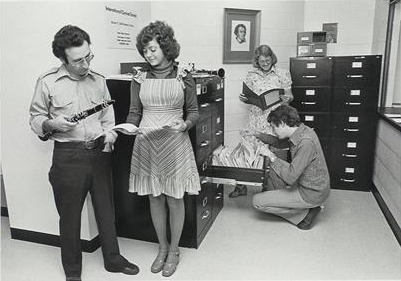
The Burnet C. Tuthill Research Library of the I.C.S.,
Cecil Gold, Director, c/o School of Music,
University of Idaho, Moscow, Idaho
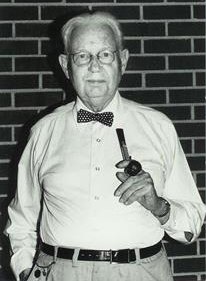
Dr. Burnet C. Tuthill
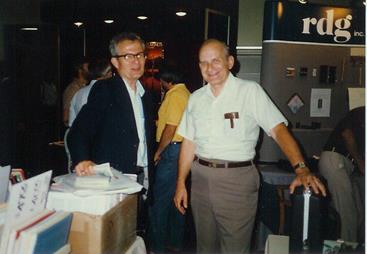
Norman Heim, Coordinator,
Research Library at the University of Maryland,
with John Mohler.
Honorary Members
The Bylaws of the Society, Article V.6, call for “a special category of Honorary Membership for persons of unusual distinction from the areas of professional service, teaching, performance, and/or lifetime achievements. During Gary Whitman’s term as President, the nomination procedure changed with more detailed documentation required of the nominee and their qualifications. Biographical materials of the following recipients appear in The Clarinet following their induction:
- Harry Rubin, 1978 (1928-2018)
- Betty Brockett, 1986 (1936-2003)
- James Sauers, 1987 (1921-1988)
- Pamela Weston, 1987 (1921-2009)
- Lee Gibson, 1998 Denton, Texas
- Ramon Kireilis, 1998 Denver, Colorado
- Ralph Strouf, 1998 (1926-2002)
- Guy Deplus, 1999 Paris, France
- George Waln, 1999 (1904-1999)
- Jack Brymer, 1999 (1915-2003)
- Himie Voxman, 2000 (1912-2011)
- Stanley Hasty, 2001 (1920-2011)
- William O. Smith, 2001 (Seattle, Washington)
- Paul Harvey, 2002 Twickenham, Middlesex, U.K.
- Mitchell Lurie, 2002 (1922-2008)
- Alfred Prinz, 2002 (1930-2014)
- John Mohler, 2003 Chelsea, Michigan
- Bernard Portnoy, 2003 (1915-2006)
- Stanley Drucker, 2004 New York, New York
- David Weber, 2004 (1913-2006)
- F. Gerard Errante, 2005 Las Vegas, Nevada
- James Gillespie, 2005 Denton, Texas
- Karl Leister, 2005 Berlin, Germany
- Clark Brody, 2006 Evanston, Illinois
- Jacques Lancelot, 2006 (1920-2009)
- John McCaw, 2006 Philadelphia, Pennsylvania
- Elsa Ludwig-Verdehr, 2007 East Lansing, Michigan
- Fred Ormand, 2008 Lawrence, Kansas
- Larry Combs, 2008 Evanston, Illinois
- Buddy DeFranco, 2010 Panama City Beach, Florida
- H. James Schoepflin, 2010 Spokane, Washington
- David Etheridge, 2011 (1942-2010)
- Béla Kovács, 2011 Budapest, Hungary
- Frank Kowalsky, 2012 Tallahassee, Florida
- Ben Armato, 2012 Ardsley, New York
- Hans Deinzer, 2013 Frankfurt, Germany
- Walter Boeykens, 2013 (1938-2013)
- Hans Rudolf Stalder, 2013 (1930-2017)
- Milenko Stefanovic, 2013 Serbia
- Michele Zukovsky, 2014 Los Angeles, California
- Eddie Daniels, 2017 Santa Fe, New Mexico
- Luis Rossi, 2017 Santiago, Chile
- Richard Stoltzman, 2017 Boston, Massachusetts
- Franklin Cohen, 2022 Cleveland Heights, Ohio
- Paquito D’Rivera, 2021 North Bergen, New Jersey
- Charles West, 2022 Centerville, Virginia
- Eddy Vanoosthuyse, 2019 Kortrijk, Belgium
- Bernard Van Doren, 2018 Paris, France
- Charles Neidich, 2018 New York, New York
- Ron Odrich, 2019 New York, New York
- Robert Spring, 2022 Tempe Arizona
- Colin Bradbury, 2023 (1933-2023)
- Philippe Cuper, 2023 Paris, France
- Giora Feidman, 2023 Hamburg, Germany
- James Pyne, 2023 (1936-2020)
Competitions
1974 marked the third annual National Clarinet Competition, open only to high school students. This competition was eventually split between the High School Competition and the Young Artist Competition (YAC) for competitors up to age 27. The later two have been international in scope for many years. For the past several years the president-elect has coordinated the Young Artist Competition. Coordinators of the High School Competition have been Gerald King, Michael Galván, Diane Cawein-Barger, Kathy Pope, Marguerite Levin, and Elizabeth “Libby” Crawford.
In 1997 the Orchestral Audition Competition (OAC) was founded and coordinated by Raphael Sanders, a member who wanted something to happen and made it happen. Raphael coordinated this from 1997 to 2007. Peter Wright stepped in from 2008 to 2011, followed by Jeremy Reynolds in 2012. Michéle Gingras coordinated the Composition Competition for many years. It attracted hundreds of entries of outstanding compositions for a variety of works that included clarinet, solo works, chamber works, etc. Performance copies of all entries are in the I.C.A. Research Library at the University of Maryland. During Gary Whitman’s term as President, the Composition Competition was reinstated. Eric Mandat coordinated from 2010 to 2012. Michael Norsworthy will begin for the 2013 competition.
An often unnoticed addition to ClarinetFests® is the Paper and Poster Presentations – Research Competition. Keith Koons was the initiator of this important addition to our conferences. After Keith, John Cipolla, Jane Ellsworth, and Douglas Monroe volunteered to coordinate these very interesting sessions over the years.
Competition Winners
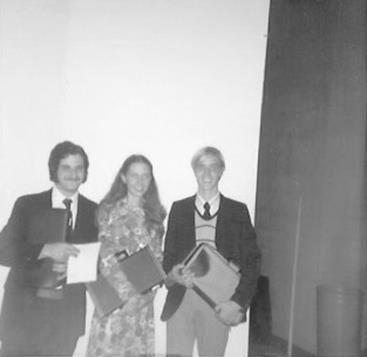
Andrew Stevens, Debbie Greene, and David Krakauer, 1974
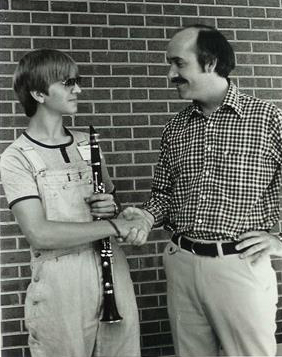
Bil Jackson and Ray Kireilis, 1976
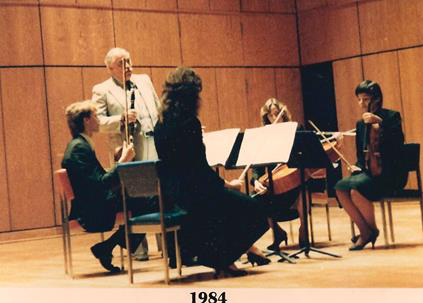
Jerry Pierce’s Premiere Performance of Tansman Commission
YOUNG ARTIST COMPETITION REPERTOIRE LIST: In 1974, the Third Annual National Clarinet Competition was open to high school and junior high school students, including graduating seniors. For 1975, the International Clarinet Competition was open not only to high school players in the United States, but anyone 19 years of age or under not yet having entered the college level – including the United States and all foreign countries. Eligibility ages changed considerably during the years following. From 1982 to 1984 clarinetists up to age 30 or under on January 1st of the competition year were eligible. The age was lowered to 22 from 1985 to 1987, raised to age 23 from 1988 to 1992, and set at age 27 since 1993. Robert Walzel and Alan Stanek compiled the list making it readily available to coordinators.
Stan Geidel got our website up and running in c1995, and Mark Charette and Kevin Jocius followed as Webmasters. David Neithamer served as our Internet Liaison for several years. Rachel Yoder currently serves as the chair of the website advisory committee and coordinates website links. Roger Garrett produced an I.C.A. Electronic Newsletter for those enrolled through the Klarinet Discussion List, an Internet discussion list started in 1996 and hosted on Mark’s server. The Electronic Newsletter was an attempt to recruit younger clarinetists to the association. Unfortunately, the newsletter was dropped. Under President Keith Koons, the groundwork for a new e-newsletter was laid using Constant Contact. E-mail “blasts” for I.C.A. announcements have been used; online voting, and membership surveys have helped organization officials define membership demographics, attitudes, and preferences.
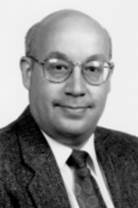
Stan Giedel
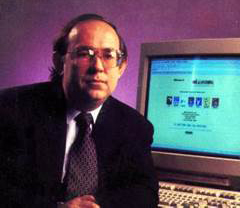
Mark Charette
Advertisers and Vendors/Exhibitors
Without the support and backing of advertisers and conference vendors/exhibitors there would probably be no journal or ClarinetFest®. They provide the necessary financial support, exchange of ideas, and materials through their advertising in the journal and conference program booklets, exhibitions, and the sponsorship of clarinet artists and teachers. The association is grateful and indebted to their generosity and cooperation.
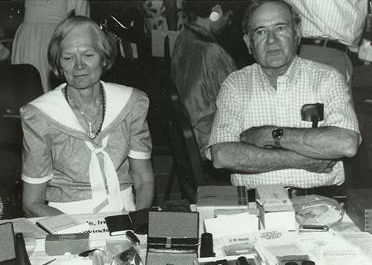
Marion and Bob Lorenzini (1918-2001)
Sounds of Woodwinds
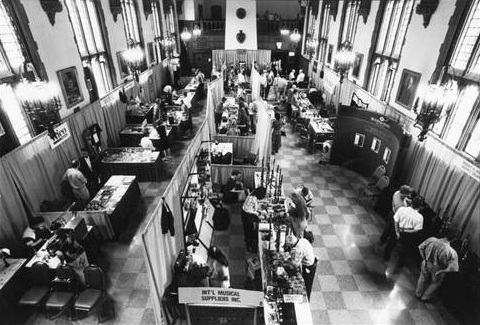
’94 Chicago ClarinetFest® Exhibit Space
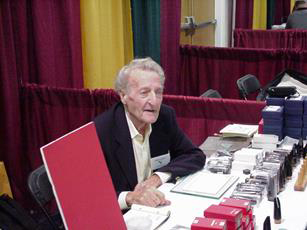
Ignatius Gennusa at Exhibits

Robert (1916-1993) and Annette Luyben (1916-1991)
Luyben Music, Kansas City, Missouri
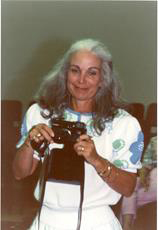
Annette Luyben
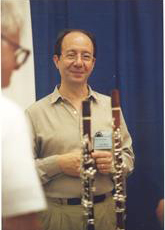
Luis Rossi, ’95 in Phoenix
State, Regional and National Chairs
- State Representatives (50)
- Regional Chairpersons (9) – no longer in effect
- National Chairpersons (43)
First National Chairmen from The Clarinet, Volume 1, Number 2:
- Avram Galper, Eastern Canada
- Melvin Cooksey, Western Canada
- Neville Thomas, Australia
- Roger Salander, Austria
- Jack Brymer, England
- Christie Lundquist, Mexico
The International Clarinet Association’s evolution from a “good idea” to our 40th Anniversary is an indication of the dedication and devotion of the instrument’s many students, performers, teachers, and aficionados. Richard Stoltzman once wrote, The Clarinet is “a good reed”. Jim Gillespie, longtime editor, has expanded our quarterly journal into a professional, peer-reviewed tome that rivals any of our sister organizations. Annual conferences are truly international in scope. The I.C.A. Board of Directors scrutinizes host site applications carefully before being approved by the membership at annual business meetings held during each yearly conference. ClarinetFests® annually attract hundreds, and more often, thousands of attendees to hear recitals of standard and sometimes obscure repertoire and newly commissioned works. Master classes are lead by today’s finest pedagogues. Large clarinet choirs comprised of conference attendees rehearse and perform during the event. The conference host now assembles a selection committee to select recitalist, etc. in a peer-reviewed process.
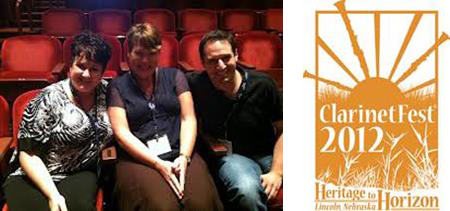
2012 ClarinetFest® Artistic Selection Committee
Artistic Director and Host Diane Barger,
Denise Gainey and John Masserini
A whole host of chamber music combinations, and ethnic musical presentations presented by a variety of artists add to the excitement. From the single National Clarinet Competition of 1974 for high school students, there are now multiple international competitions and new music commissions. In addition to many solo and potpourri recitals, lectures and research presentations, sessions for the use of the latest technological innovations in teaching, composing, and performing enable attendees to pick from a variety of options during their four to five day sojourn. Evening concert galas feature soloists performing with professional string quartets, symphony orchestras, community and military bands, etc. We are regaled by some of the most outstanding symphonic and jazz/klezmer performers of our day. Exhibitors are numerous and exhibition spaces large with many tryout rooms. Industry vendors/exhibitors attract attendees to try the latest equipment and make purchase of needed music, reeds, mouthpieces, bells and barrels, etc. We have evolved thanks to a remarkable team of individuals dedicated to the clarinet.
Readers of this history are requested to submit their remembrances and photos of previous and future conventions to the association’s historian for inclusion in the 50th anniversary edition in 2023.
© Alan E. Stanek, Pocatello, Idaho 2013
Copyright© ICA 2004 2013. All Rights Reserved.

